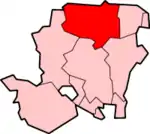Up Nately
Up Nately is a small village in Hampshire, England, located to the south east of Basingstoke. Its nearest railway station is in Hook, three miles to the east of the village. The Basingstoke Canal runs through the village from the former Penny Bridge (on the Greywell Road) in the west, under Brick Kiln bridge (Blackstocks Lane), Slades bridge (Heather Lane) and Eastrop bridge (Heather Row Lane), although it is interrupted to the east of the village by the collapsed Greywell Tunnel.
| Up Nately | |
|---|---|
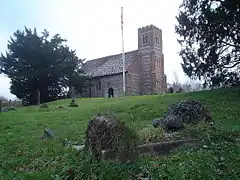 St. Stephen's church | |
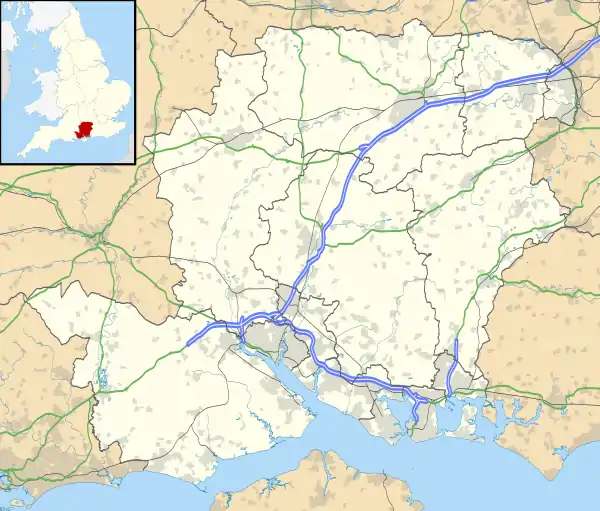 Up Nately Location within Hampshire | |
| Population | 333 (2011 Census)[1] |
| Civil parish | |
| District | |
| Shire county | |
| Region | |
| Country | England |
| Sovereign state | United Kingdom |
| Post town | BASINGSTOKE |
| Postcode district | RG27 |
| Dialling code | 01256 |
| Police | Hampshire |
| Fire | Hampshire |
| Ambulance | South Central |
| UK Parliament | |
History
Originally part of the Great Manor of Mapledurwell, Up Nately was created as a separate estate in the early part of the 12th century, when it was granted to the Cistercian Abbey of Tiron in France by Adam de Port, Lord of Mapledurwell.[2] and confirmed by Henry I. Tiron sent a colony of Benedictine monks to settle in its new estate, which became Andwell Priory.[3][4] As an alien priory with an allegiance to a foreign enemy, it was sequestered by Edward III. It was bought in 1391 by William of Wykeham, Bishop of Winchester who then bestowed it on Winchester College.[5][6] Remains of the priory can be seen today.
In 1535 Corpus Christi College, Oxford, also acquired some land in the village in Heather Row Lane, together with the grant of the manor of Mapledurwell.[7]
In 1870-72, John Marius Wilson's Imperial Gazetteer of England and Wales described Up Nately as:
a parish in Basingstoke district Hants; 1 mile S of Nately-Scures, and 4 E by S of Basingstoke r. station. Post-town, Basingstoke. Acres, 1,013. Real property, £805. Pop., 99. Houses, 26. The living is a vicarage, annexed to the vicarage of Basing, in the diocese of Winchester.[8]
For many centuries farming has been the dominant activity in the village, although there have been periods of industrial activity such as cloth production in the 15th and 16th century and brick making at the end of the 19th century.[9] There are a number of chalk and sand pits in fields surrounding the village, that are also shown on a historic map, indicating historic quarrying activity.[10]
Brickmaking
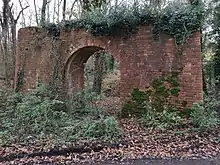
In 1897 Sir Frederick Seager Hunt, a Conservative Party politician and distiller, who two years earlier had bought the Basingstoke Canal, invested £20,000 to set up the Hampshire Brick and Tile Company on 32 acres of land in Up Nately. Hunt's aim was to revive trade in the upper reaches of the canal and in particular use the canal to supply bricks from the brickworks to replace the wooden huts at the Army barracks in Aldershot. Bricks from Up Nately were supplied to local builders in towns along the Canal, and accounted for half the traffic in bricks. To fire the kiln, about fifty tons of coal per week were supplied by barge from Basingstoke.
Sir Frederick sold his shares in the company and the company went into receivership by 1901. The site was used by the Nately Pottery Company from 1901 to 1908. Some of the brickworks buildings remained until the 1940s and the Kiln Chimney was demolished during the Second World War.[11]
As well as the brickyard arm, the arches of two kilns and some sheds also remain in Heather Lane. The name of Brick Kiln Bridge is also a legacy of the brickworks.
Governance
In 1880 Up Nately became a civil parish of 1,149 acres. In 1932 it merged, along with its neigbouring parish of Andwell, with Mapledurwell to form the current civil parish of Mapledurwell and Up Nately[12] and part of the Basing ward of Basingstoke and Deane borough council.[13] The borough council is a Non-metropolitan district of Hampshire County Council.
Local Nature Reserve
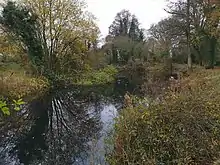
Since the partial collapse of the Greywell Tunnel in the 1930s, the last five miles of the Basingstoke Canal from the tunnel to Basingstoke has remained isolated from the rest of the canal. Whilst most of this section has been drained, the part between the western end of the Greywell Tunnel and Penny Bridge in Up Nately still has water in it and has been preserved by the Basingstoke Canal Authority as the Up Nately Local Nature Reserve.[14]
The Reserve, which has an area of 2.83 hectares (6.9 acres) and is part of Butter Wood Site of Special Scientific Interest, supports the following wildlife: Coot, Moorhen, Mallard Duck, Little Grebe, Ruddy Darter, Water Vole, Ransoms and Badgers. The Greywell Tunnel is an important hibernation site for bat species including the Pipistrelle, Natterer and Daubenton. The rare Barbastelle bat has also been recorded there.
Penny Bridge marks the start of a public footpath eastwards along the length of the Canal's former towpath. However the Basingstoke Canal Society, working with local authorities, aims to open up a foot and cycle path to the west which would, as close as possible, follow the route of the canal from Penny Bridge to Basingstoke.[15]
St Stephen's Church
St Stephen's Church dates from around 1200, with 15th and 19th century alterations and is Grade II* listed.
The church includes a memorial to Alfred James Clark. Clark had joined the Army in 1914. In 1916, the hospital where he had been a patient was bombed. When erected, the memorial was unusual, being the second such one-man memorial in the UK.[16]
The altar cloth has a mysterious inscription to the fallen of the Great War. It lists sixteen names of servicemen who are from different regiments, different parts of the country, and who died in different places. The association between them is unclear.[16]
The churchyard contains the war graves of Frank Evans[17] and Alan Sidney Woodbridge.[18]
Further reading
- Friends of St Stephen's St Stephen's Church Up Nately (church guide, available from the church)
References
- "Civil Parish population 2011". NOMIS Local Area Report. Office for National Statistics. Retrieved 29 November 2020.
- "Basingstoke and Deane Council, Conservation Area Appraisal: Up Nately" (PDF). Retrieved 29 November 2020.
- "British History Online, A History of the County of Hampshire: Volume 2, Alien houses: Priory of Andwell". Retrieved 1 December 2020.
- "Victoria County History of Up Nately" (PDF).
- "History of Up Nately". Retrieved 21 August 2010.
- "Victoria County History of Up Nately" (PDF).
- "Institute of Historical Research, School of Advanced Study, University of London, Up Nately and Andwell" (PDF). Retrieved 29 November 2020.
- "History of Up Nately in Basingstoke". Retrieved 29 November 2020.
- "Institute of Historical Research, School of Advanced Study, University of London, Up Nately and Andwell" (PDF). Retrieved 1 December 2020.
- "National Library of Scotland georeferenced map". Retrieved 1 December 2020.
- "Basingstoke Archaeological & Historical Society, Newsletter 198, February 2012" (PDF). Retrieved 29 November 2020.
- "Hampshire County Council's legal record of public rights of way in Hampshire" (PDF). 2008. Retrieved 28 October 2010.
- "Basingstoke and Deane Wards info". 2010. Archived from the original on 24 October 2010. Retrieved 28 October 2010.
- "Natural England Up Nately LNR". Retrieved 29 November 2020.
- "Basingstoke Canal Society The unnavigable section into Basingstoke (and the proposed "Hants and Berks Canal" link)". Retrieved 1 December 2020.
- Friends of St Stephen's St Stephen's Church Up Nately
- EVANS, FRANK
- WOODBRIDGE, ALAN SIDNEY
External links
| Wikimedia Commons has media related to Up Nately. |
- History of Up Nately
- Up Nateley
- Conservation Area Appraisal: Up Nately and Conservation Area Map
- Listed Buildings in Mapledurwell And Up Nately, Hampshire, England
- Hampshire Treasures: Volume 2 (Basingstoke and Deane) pages 177, 179, 180, 181, 182, 183, 184, and 185
- St Stephens Church
- St Stephens Church, Up Nately (Online version of much of the church guide)
- St Stephen's Church, Up Nately
- Stained Glass Windows at St. Stephen Up Nately, Hampshire
